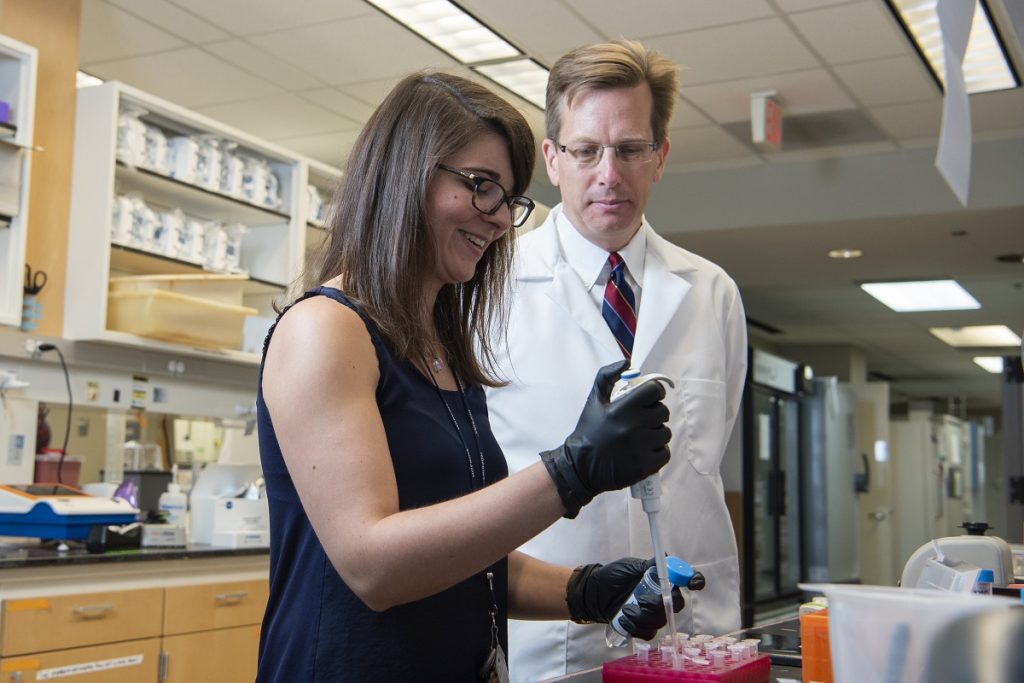Johns Hopkins UniversityEst. 1876
America’s First Research University
Cell biologist Andy Ewald and biomedical engineer Joel Bader had a vision: to unravel the genetic mysteries of breast cancer by using computer models to uncover molecular patterns among “organoids,” 3-D cultures of breast tissue grown from the cells of cancer patients. In 2018, they were awarded a $5 million grant from the National Cancer Institute to create the Johns Hopkins Center for Cancer Target Discovery and Development, which recruits experts and up-and-comers from a variety of disciplines to research cancer in unique ways.
“Structurally, we’re bringing together really diverse expertise,” Ewald says. “My background is physics and cell biology. Joel’s is in drug development and computational biology. My lab does the experiments and his lab does the math.”
Some of the most exciting developments in biology are happening at that interface between biology and physical sciences, Ewald says. “What we’re doing wouldn’t be possible if we were reading each other’s papers and trying to build on them from afar. You can’t get to the same place that you can when you’re working together.”
A year and a half later, how has that exploration progressed? We checked in with Ewald for this installment of What Happened Next?

The most fundamental question in treating a patient is which molecules should we be targeting with modern drugs? More than 90 percent of deaths are attributed to metastatic stages, but seven percent of research in breast cancer is on the metastatic stages.
There’s a renewed emphasis on studying the metastatic process in the last five years thanks significantly to efforts from patient advocacy groups and foundations. Those efforts made it easier to raise funds, and that was really critical to our success here ― they enabled us to make great progress in a relatively short period of time. Philanthropy is important even while the grant is running because it allows us to move in some areas very rapidly and test new ideas.
Metastasis is a multi-step process. The cancer cells need to leave, travel through the adjacent tissue, survive traveling through the blood vessels, escape the immune system the whole time, and grow out in a new organ. We wanted to know, what are the molecular tools they’re using to survive the journey through the body? In 2013, we showed that there’s a set of molecular equipment that cancer cells turn on when traveling through the body. As they travel through the body, they tend to do so in groups of cancer cells that are stuck to each other with molecular adhesions ― like molecular velcro.
This basic framework has stood since the late 90s: If you look at the migration of cancer cells in a petri dish, how fast they migrate correlates inversely with their expression of E-cadherin [an adhesion protein]. When we take away E-cadherin, we see more invasion. This gave people a framework for thinking of E-cadherin as repressing cancer invasion. We still agree with that! But metastasis is a multi-step process. Making the first step go faster doesn’t mean the whole process works better.
Travel through the body is molecularly stressful. Most cancer cells that leave die along the way and don’t form a metastasis. They’re right at their limit of their survival. If you push them any harder, they die. We used genetic techniques to delete E-cadherin and they increased their local invasion. They get out to the local area much better, but they can’t survive the journey to a distant organ. Or to use a sports metaphor, as they lose E-cadherin, they get better at the 100-meter sprint and win that event, but they tear a hamstring and can’t complete the decathlon.

No, because overwhelmingly the primary breast cancer tumor can be surgically removed. One of the biggest worries is that you don’t know if the cancer cells have spread to distant organs. The question is how can we eliminate those few cells left in the body in a way that’s least damaging to the patient? We showed that when we lose this class of adhesion, many types of chemical signals changed, and we were able to use this information to identify ways to increase and decrease the survival of the cancer cells.
Turning these laboratory insights into patient benefits. Now we need to test what types of breast cancer this insight is most useful for and identify the most promising methods to disrupt adhesion-based survival. We think this is going to be very relevant in many other cancer types. Most solid cancers ― breast, pancreas, liver, lungs, everything that’s not a blood cancer ― will be expressing this protein or one very similar to it.
The thing we’re going to focus on next is the identification of targets. We’re going to say “aim at this molecule” and then partner with other people to build out the drugs. We have drug screens running right now, so we can try every drug out there in the oncology pipeline, drugs from other diseases, and novel compounds that are not yet drugs for any disease. We have another active project where we’re using genetic screening to identify new targets down at the gene level to turn into therapeutic strategies. We’ve done great stuff in the past, but the most exciting stuff is in the future.
Interested in supporting the Johns Hopkins Center for Cancer Target Discovery and Development?
Topics: Foundations, Friends of Johns Hopkins Medicine, Johns Hopkins Medicine, Fuel Discovery, Promote and Protect Health